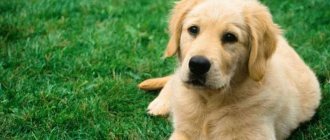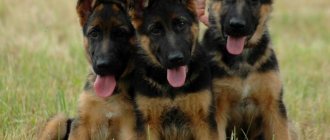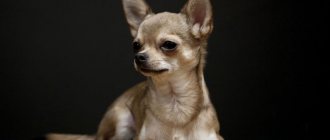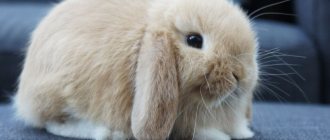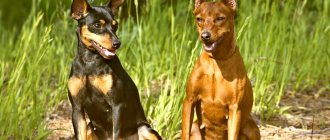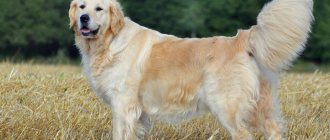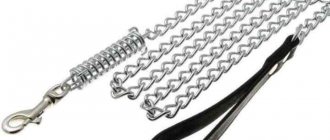All about the breed
Mini is not an independent breed, and small, pocket puppies appear from standard parents. Such an event occurs very rarely, which is what many unscrupulous sellers take advantage of. After all, the birth of non-standard babies is considered a marriage. This is a very expensive and rare variety, and how the animal will grow up becomes clear only after eight months.
Appearance
The dog is small in size. Even in medieval China, they were called “sleeve” . This name is no coincidence, because court ladies at the imperial court wore them in the wide sleeves of their kimonos, instead of muffs.
The weight of an adult pet cannot exceed 3 kg (in some countries - 2.5 kg), and the height at the withers reaches 12-15 cm. It has a massive head, with a neat nose, partially recessed inside the skull. The ears are hanging, slightly turned forward, with very long hair at the tips. The paws are strong, powerful, and the hind limbs are slightly shorter than the front ones.
A distinctive feature of both mini and standard representatives is a chic, thick mane, long hair, especially on the ears and tail. The eyes are bulging, large and expressive, which causes frequent vision problems. The coat color can be white, black, reddish-fawn, with a dark mask on the muzzle. The eyes and nose are dark.
Character and behavior
Pekingese are very proud, brave and courageous. The temperament is calm, balanced, they sense a person’s mood well, and will not bark unless absolutely necessary.
At the slightest threat, they are ready to rush at the offender, even if he is much stronger and larger. They are extremely touchy, vindictive , and do not tolerate people raising their voices at them or invading their personal space.
Families raising children are not recommended to have them. They are smart, intelligent, friendly, but very stubborn and willful. Therefore, they will have to be trained and educated from an early age, devoting a lot of time and effort to this process. The learning process is not at all easy, and it also happens that it becomes necessary to involve a professional dog handler.
Interestingly, they do not need long walks. Ideal for retirees and people leading a sedentary, inactive lifestyle. It is enough to walk Pekingese twice a day for 20-30 minutes. They prefer to spend time at home, in warmth and comfort. They are excellent watchdogs, love to play with their owner, but are very jealous of other pets and family members.
History of the breed
The ancestor of the Pekingese is considered to be an ancient Chinese dog called “toy”. It was smaller than modern representatives, but the exterior was similar. Mixing the blood of Toys with other dogs of similar sizes led to the appearance of the first Pekingese.
From this moment on, the life of the imperial dogs can be called heavenly. They lived exclusively in the palaces of their generous masters. They had their own minister, spacious bamboo pens with beds, quality care and personal servants. They were decorative dogs; they were not used for service or protection; in temples they were worshiped along with deities.
Pekingese were bred only for rulers and those close to them. Among the common people, fluffy dogs with a specific facial expression were not found. The theft of such pets was severely punished regardless of the status of the offender. Only the emperor had the right to give a puppy.
Small dogs with a short muzzle and long feathering became a real symbol of happiness and prosperity among the imperial dynasties. They were depicted on frescoes, and sculptures with their silhouettes were installed at the palace entrances. The rulers dedicated poems to these aristocrats of the dog world and carried them with them, pressing them to their bodies. They were very angry with the servants if the pets were sick or sad.
The turning point in the history of the breed coincided with the coup d'etat in China. The government was overthrown by the people, numerous bloody uprisings caused the introduction of foreign troops into imperial territory. When the rebels reached the royal mansion, the emperor decided to burn them to the ground. Not only buildings were damaged, but also innocent dogs. The British military managed to save several Pekingese and take the unfortunate animals to Europe.
Thus began a new stage for the breed. In England they were considered very expensive dogs and were presented as valuable gifts. An ordinary person could not buy such a puppy; there were cases when tens of thousands of pounds were offered for a dog, but the owners steadfastly refused to sell their pets.
We suggest you familiarize yourself with: African dwarf cat care and maintenance at home
The British managed to accustom some Pekingese to shepherd service, and they managed to work almost as well as shepherds. But such use contradicts the true purpose of a companion dog. In addition, the structure of the body and respiratory tract of Pekings does not allow them to move for a long time and actively, especially when chasing livestock.
In 1891, British dog handlers recognized the breed and gave it the name “Pekingese.” They offered other options, for example, “Peking Chin”, “Peking Pug”, “Peking Spaniel”. They were brought to the USSR in the middle of the 20th century. There was a large population in Leningrad and the region. Later, Pekingese became popular and remained at the top of the list of common breeds until the mid-90s.
At the same time there was a change in the breed standard. “Old-type” or Soviet dogs gave way to short-legged and fluffier representatives. However, both groups can participate in exhibitions and have offspring with paperwork.
Care and maintenance
The main problem will be grooming. Shedding, severe loss of undercoat, requires regular brushing. You need to bathe your dog once every six months, and the rest of the time, you can use dry shampoo. Particular attention should be paid to cleaning after a walk or feeding.
We must not forget about the eyes, which also need to be cleaned of dust and dirt. You will have to wipe them daily using a soft, lint-free cloth. Dogs are prone to various eye diseases (eye loss, conjunctivitis, keratitis). Even a simple walk in tall grass can result in injury. Abundant purulent discharge and lacrimation are a serious reason to contact a veterinarian.
The animal's teeth and claws require additional care. Moreover, you need to brush your teeth daily , using a piece of gauze wrapped around your finger, and trim your nails as they grow (once a month). The ears are cleaned once every 2 weeks using cotton swabs soaked in a solution of hydrogen peroxide.
Recommendations from experts
The following tips will help you properly organize the nutrition of puppies and adult Pekingese:
- Food should be at room temperature to avoid negative effects on the digestive system.
- Feeding the Pekingese is carried out by the hour at regular intervals. Then the gastrointestinal tract will work smoothly.
- The dog is given a separate place for feeding. It is chosen once and does not change throughout life.
- Both puppies and adult Pekingese have no sense of proportion. Despite the fact that they have a small stomach, they are able to eat much more than normal. Therefore, the owner should control the amount of food consumed and avoid overfeeding.
- Due to the structure of the muzzle, it is inconvenient for animals to eat liquid food. They also have poorly developed fangs, which makes it difficult to chew dry food pellets and hard foods. It is recommended to soak the former in water, and cut the latter into small pieces.
- Clean water should always be within reach. It is updated 3-4 times a day.
- If the Pekingese is capricious and does not want to eat any product, the bowl is removed. After 20-30 minutes they take her out again. A hungry dog is unlikely to refuse food.
The following advice from veterinarians and dog handlers will help you properly feed puppies and adult Pekingese:
- During the first molt, when baby hair changes to adult hair, the menu is enriched with algae, mussels, oysters and other seafood. However, you need to remember that you cannot feed your Pekingese these foods at an earlier age.
- In summer, an adult Pekingese should eat more fiber, and in winter, protein foods.
- It is not recommended to rely heavily on buckwheat, because it can cause urolithiasis.
- The bowl is removed 20 minutes after the start of feeding. If there is food left in it, the portion size is reduced, and if the dog continues to lick the empty dishes, it is increased.
- You should not offer your pet treats often, because then he will refuse to eat regular food.
- Sedentary adult Pekingese dogs should consume about 300 calories per day. With moderate activity, the energy value increases to 400 calories, and with high loads - up to 600 calories.
If you feed your Pekingese correctly from childhood, he will have good health, which means he will live a long life. Therefore, the owner needs to take the most responsible approach to preparing a diet for a puppy and an adult dog.
The Pekingese moves little, has a flattened jaw and weak fangs. These features should be taken into account when creating a diet. Prohibited foods include sweets, pickles, and bones. There should always be clean water in the bowl.
For the first month of life, the puppies are fed only by the mother. In the fifth week, the breeder begins complementary feeding. He usually uses canned meat from trusted manufacturers. You can switch to natural nutrition. It is based on cow's milk, boiled minced beef, and cottage cheese. Gradually, fruits and vegetables are introduced into the diet: apples, zucchini, carrots.
Then you can gradually change the diet in favor of natural food or feed. In the second case, you need to buy only premium pates or gravy without a strong taste or smell. During this period, Pekingese eat 4-5 times a day with equal intervals between meals.
In the fourth or fifth month, daily meals are already divided into 3 times: breakfast, lunch, dinner. Natural food is supplemented with boiled cereals, eggs, and raw potatoes. Before changing baby teeth, it is necessary to increase the volume of fermented milk products, especially cottage cheese. Boiled cartilage or hard treats from a pet store will help “scratch” itchy gums.
At six months, the puppy turns into a teenager. His diet is replenished as much as possible and no longer differs from the menu of an adult dog. During this period, some pets become lactose intolerant. This change is considered normal and does not require treatment. It is necessary to remove milk from the diet and leave fermented milk products. If it is convenient for the owners, eating 2 times a day is allowed.
Adult dogs
When purchasing industrial food, you should take into account the anatomical features of the Pekingese. Their flat muzzle and weak fangs prevent them from chewing dry pellets. The dog often swallows them whole, which leads to poor health. The basis of this type of diet should be canned food, pates and gravy. Choose products whose labels indicate the class (premium, super-premium) and breed.
Natural nutrition must be carefully selected. Pekingese are not very active, so they are prone to gaining excess weight. Choose lean meats, give plenty of vegetables and fruits, and cheese is a healthy treat. Thick fur hides the size of the dog's body. Therefore, she needs to be weighed once a month and the menu adjusted depending on the numbers on the scales.
During the change of milk teeth, the puppy needs calcined foods. When the soft fluff falls out and adult hair grows in its place, seafood supplements are needed. A special complex of vitamins is given during pregnancy and old age. In addition, preparations for annual feeding are produced.
If you monitor your dog's behavior, you can understand what substances it lacks.
- Picks up cigarette butts - vitamin P.
- Bites shoe insoles - group B.
- Licking plaster - calcium.
- Eats feces - B12.
- Bones are bent - D.
The well-being and health of your pet depends on proper care. Pekingese have characteristics that need to be taken into account.
Wool
Puppies are taught to groom their fur from childhood. The owners comb out the undercoat every day, untangle knots, and cut off tangles. If lumps of dirt cannot be removed with a comb, the dog is given a bath. Frequent water procedures are harmful. They dry out the skin and cause colds and ear infections. To prevent unpleasant consequences, you need to wash your dog with mild shampoo, dry with a towel and dry with a hairdryer.
Owners should regularly clean their Pekingese's bulging eyes. To do this, you need to buy a solution and a special lint-free cloth. Gently wipe the area around the eyelids to remove mucus and deposits. Dogs of this breed are prone to protrusion and even prolapse of the eyeball. In this case, moisten the mucous membrane with a 1% boric acid solution and contact a veterinarian.
Keeping a dog at home requires regular oral examinations. If you notice yellowness of the tooth enamel or redness of the gums, you should consult a specialist. Pet stores sell hard, elastic treats made from cartilage and tendons. Their goal is to cleanse the interdental space. You can brush your teeth with a special brush, but dogs often shy away from this procedure.
When swimming, water should not get into your ears. When brushing daily, it is necessary to inspect the ears. Clean them from yellow plaque with special sticks. The appearance of brown crusts indicates infection with parasites. Treatment is carried out at home by instilling a product that is sold in pet stores.
Small breed dogs need to have the tips of their nails trimmed. Due to low activity, the claws do not grind down on the asphalt. They continue to grow, become rounded and dig into the pads. This problem can only be solved surgically. The pet store sells sharp wire cutters that can easily cut off excess tissue. In addition, owners should shorten the hair on their paws so that it does not spread along the ground.
A haircut
The Pekingese's long, thick coat requires careful grooming. A neat haircut can make this task easier. A trimmed dog can withstand the summer heat more easily. She gets dirty less often, brings ticks less often and suffers from skin diseases. After 10 years, her mane loses its silkiness and shine. At this age, grooming is also necessary for aesthetic reasons.
We suggest you read: What to feed a pigeon chick at home
Possible diseases
Mini dogs are prone to the same diseases as regular dogs.
The most common pathologies are:
- skin diseases,
- joint damage, paralysis,
- intervertebral hernia,
- bone fragility,
- tumor of the perianal glands,
- respiratory tract diseases (bronchitis, laryngitis, rhinitis),
- genitourinary diseases,
- breathing disorder,
- cardiac pathologies.
But the most sensitive organ is the eyes. The most common ailments are cataracts, ectropion, keratitis, and ulcers. A mandatory condition for health will be vaccination and quarterly examination by a specialist. The first vaccination is given at three months. Life expectancy, in this case, is about 14-16 years.
Nutrition
When buying a puppy, it is important to consult with the breeder regarding feeding. This can be either ready-made super-premium food or natural food. When eating natural foods, you need to ensure that the diet is completely balanced and complete.
The menu should include:
- boiled beef and chicken, offal (at least 50% of the total daily ration),
- buckwheat, rice and oatmeal (with water and without salt),
- fermented milk products, cottage cheese,
- fresh seasonal fruits and vegetables,
- fish fillet (boneless!).
Bones, both large and small, should not be given to animals. Avoid sweet and fatty foods, potatoes, flour products, and baked goods. Special vitamin supplements are added to food.
What to feed an older dog (old dogs)
Both a puppy and an adult Pekingese should not be fed the following foods:
- salted, fried, spicy, pickled dishes;
- freshwater fish;
- tubular bones;
- sweets and baked goods;
- semi-finished products;
- raisins, grapes, kiwi and citrus fruits;
- foods containing cocoa and caffeine;
- fatty meats, smoked meats and sausages;
- corn, legumes, potatoes, soybeans, white cabbage, semolina.
The number of meals depends on the age of the animal. As the puppy grows, they are fed less and less, gradually moving towards two meals a day.
Up to 1.5 months, food is given 6 times a day, even at night, because puppies can only eat a small portion at a time. Subsequently, the frequency is reduced:
- from 1.5 to 3 months – 5 times;
- from 3 to 6 months – 4 times;
- from 6 to 12 months – 3 times.
A one-year-old Pekingese is considered an adult. It is enough to feed him only in the morning and evening. If you don't walk or play with your dog much, it is acceptable to limit yourself to one meal.
The daily amount of food is calculated using the formula: 70 g of feed per 1 kg of weight.
For example, an adult Pekingese weighing 4 kg should be given 280 g of food per day.
However, each dog is individual, so the owner must monitor its condition. You should not allow yourself to gain excess weight, because this is fraught with problems with digestion, heart and blood vessels.
Its proper development and health depend on what a dog eats in the first year of life.
An unbalanced diet for a puppy threatens growth retardation and the appearance of chronic pathologies.
For the first 4 weeks after birth, puppies are breastfed. Together with milk, they receive all the nutrients necessary for growth and antibodies that form immunity.
When there is not enough milk, puppies are fed special formulas. They are purchased from veterinary pharmacies and bred according to instructions.
For up to 12 days, bottles with a nipple are used for feeding, then the food is poured into a shallow saucer.
Diet up to six months
Complementary foods are introduced at one month of age. Many breeders believe that it is better to feed babies with natural products. If necessary, the transition to dry food can be made when the pet becomes an adult.
A one-month-old puppy can eat:
- preferably goat's milk, but low-fat cow's milk is also suitable;
- chopped meat;
- meat broth.
If the baby is developmentally delayed, in consultation with the veterinarian, special supplements are purchased for malnourished puppies.
At 2 months, the pet is usually handed over to new owners.
To avoid health problems, you need to feed your Pekingese puppy in the usual way.
Gradually the diet is enriched:
- porridge;
- vegetable purees;
- fermented milk products.
At 2 months, a puppy eats about 180 g of food per day. It is divided into small parts so as not to stretch the stomach.
At 3 months, soft-boiled eggs are added. The portion is increased by 20-30 g.
From 4 months, the puppy is allowed to feed offal. The amount of kefir and cottage cheese is increased because teeth change begins, and the dog needs increased doses of calcium. Calcined supplements are administered on the veterinarian's recommendation.
By 6 months, the puppy is fed the same foods as an adult dog. However, he gets food more often because he continues to grow.
The puppy continues to be fed intensively to ensure proper development. It is advisable to exclude milk by this time, because adult Pekingese cease to absorb it. Instead, puppies are given fermented milk products.
The food remains high in calcium and protein for up to a year, because the skeleton and muscles are not yet formed.
When the puppy turns one year old, he begins to be fed in accordance with the norm for adult dogs.
The basis of an adult dog’s diet (about 50%) is meat products. Organ meats are less nutritious than whole meats. Therefore, their number should be increased by about a third.
Meat can be given raw if the owner is confident in its quality. Otherwise you need:
- scald it with boiling water;
- boil;
- freeze for 2-3 days to kill parasites.
An adult Pekingese is fed porridge with boiled fish fillet, which replaces meat, 2 times a week. River fish is not suitable because it contains many small bones. They can get stuck in the esophagus and injure the animal’s delicate gastrointestinal tract.
Adult Pekingese are not picky when it comes to cereals. However, they should not be fed instant cereals. It is important not to overcook the dish - the dog will most likely refuse food that resembles jelly in consistency.
We invite you to read: Pros and cons of French Bulldog dogs
Once a week, boiled yolk is added to the food of puppies and adult Pekingese. The egg can be anything:
- chicken;
- goose;
- quail;
- turkey.
It is better to avoid raw eggs - there is a high risk of infecting your pet with salmonellosis.
Adult Pekingese are given vegetables both boiled and raw. The optimal amount is 20% of the daily food volume.
Both puppies and adult Pekingese willingly eat a variety of fruits. They can be fed to your pets throughout the day or used as a reward for training.
The table shows an indicative menu for an adult Pekingese for a week.
| Day | Feeding time | Products |
| 1 | Morning | Beef with vegetables |
| Evening | Boiled chicken, cottage cheese with fruit | |
| 2 | Morning | Fish porridge |
| Evening | Boiled liver with vegetables | |
| 3 | Morning | Meat porridge with egg yolk |
| Evening | Chicken with herbs and cottage cheese | |
| 4 | Morning | Boiled heart, porridge, kefir |
| Evening | Rice, beef pieces, vegetables | |
| 5 | Morning | Meat porridge with cottage cheese |
| Evening | Porridge with vegetables, cottage cheese with fruits | |
| 6 | Morning | Fish porridge |
| Evening | Meat porridge with vegetables | |
| 7 | Morning | Rice with turkey |
| Evening | Porridge with vegetables, cottage cheese |
Pekingese live on average 12-15 years. From the age of 8 the pet begins to age. At this age, adjustments should be made to his diet.
An aging dog is fed mostly soft food because its teeth become less strong. If the Pekingese is accustomed to dry food, buy products from lines for older animals.
Since the dog moves even less than usual, the caloric intake of the diet is reduced. The amount of cereals is kept to a minimum, replacing them with vegetables and meat. To maintain healthy bones and joints, include glucosamine and chondroitin supplements.
A veterinarian will give individual recommendations for feeding an aging Pekingese, taking into account the animal’s health condition.
If you have illnesses, a specialist will prescribe auxiliary supplements and help you choose a diet.
The diet of an adult Pekingese is changed from about 30 days, because until this moment the puppies do not develop as intensively.
From week 5, the daily rate is increased by approximately 15% every 7 days. The Pekingese is fed 3 times at first, and by the end of pregnancy - 4-5 times a day. Portions are made small so as not to overload the stomach, which is squeezed by puppies.
Pekingese are given more meat, vegetables and fruits. Together with the veterinarian, feed additives are selected.
Nursing Pekingese also need more food, so they continue to be fed the same way as in the second half of pregnancy.
Immediately after birth, food is given about 7 times a day. It is crushed to a mushy consistency. Fresh vegetables are pre-boiled.
By the end of the first week, the frequency of feedings is reduced to 5 times a day, but the total volume of food is still approximately 1.5 times the norm.
When all the puppies are taken apart, the amount of food is adjusted to the usual amount.
Owner reviews
- Alina: Recently, a friend of mine who breeds Pekingese dogs got a miniature puppy in her usual litter. At first she wanted to keep him, but a year later I finally persuaded her to give the baby to me. At the age of one, he weighed a little more than 1.5 kg. Despite its size, it is an excellent defender and guard.
- Olga: For me this is the best dog. The Mini Pekingese is not a separate breed, and its miniature size is considered rather a disadvantage. Several times my dogs gave birth to small puppies. But they are not used for breeding.
Rules of care
This dog can be easily kept in an apartment and does not require special care. Of course, if you can't stand the smell of a dog or pieces of fur stuck to the carpet, it's better not to get a Pekingese. The dog sheds 2 times a year and believe me, there will be a lot of fur during this period.
Caring for your Pekingese during shedding requires careful care. You should get a set of combs and brushes in advance for combing out thick fur. Also, a damp cloth may be useful to remove it. You can comb short hair with a massage brush; it is better to comb long hair with a large comb with wide serrations. For tangled wool, a special tool is sold - a “tangle cutter”. When combing, it cuts off the crumpled hair.
Due to the special structure of the skull, the Pekingese does not tolerate hot weather very well. His nose is unable to process and cool air. For a pet to live comfortably, the house must be cool. If you had air conditioning in your apartment before you got a dog, that’s great. If not, then try to ventilate the rooms often or lay a damp towel in the place where the Pekingese is resting. Heat will have a bad effect on your pet's condition.
| There was a case when the owner left the baby alone in the car on a hot day and went to the store. When he returned, 30 minutes had passed and he found the animal already dead. |
Don't believe people who say that you don't need to walk your Pekingese often. The dog should get its share of fresh air. Walk for at least 15 minutes, twice a day, and you will forget about your pet’s bad behavior, illnesses, and so on. After walks, be sure to wash your dog. They love to be clean and do not tolerate dirt, so sometimes they try to demand to be brushed. To prevent your dog from licking itself, wash its paws and underbelly in a small basin after walking.
Small dogs can go to the toilet outside or in a special litter box for dogs in the apartment. Read how to toilet train a Pekingese puppy here. Let your pet play outside only with small toy dogs. It will not be difficult for a large dog to injure a baby or even worse. To protect Pekingese from other dogs and cats, owners even buy gas canisters.
You can feed Pekingese porridge with meat and vegetables or industrial food twice a day. More about how to feed the Pekingese is written in our article: How and what to feed the Pekingese.
When changing teeth
When they are puppies, Pekingese dogs love to chew on everything. Due to the special structure of their muzzle, they will not cause much harm to your furniture, but it is better to put the wires away from the prankster! In order not to worry about your belongings and interior items, buy “delicious toys” with the smell of meat at the pet store.
Transport
How to care for your Pekingese during transportation? Ornamental babies tolerate short-term trips wonderfully. The main thing is not to be too hot. On a long journey, you should stock up on: a container for transportation (the Pekingese should have its own special corner where it will not be disturbed); in the hot summer, you need to wet the rags on which the baby lies. The dog will be comfortable if you wet it completely or spray it with water (a kind of coat conditioner).
You are allowed to travel with your dog in the cabin. The main condition is that the weight including the bag for transportation should not exceed 8 kg. But if the main weight exceeds the permissible 8 kg, you will be forced to check the dog in the luggage compartment. This will be a strong emotional blow for the Pekingese. To protect yourself and your pet, it is better to buy him a separate ticket and enjoy the flight with your four-legged friend.
| The Legend of the Pekingese Once upon a time, there lived a lion who fell in love with a monkey. This is how a dog with the face of a monkey and the fearless character of a lion was born! This is how the origin of the imperial dog, the Pekingese, is explained. |
A haircut
When choosing what to feed your Pekingese at home, you can choose one of two diet schemes:
- Natural. Then the dog’s menu consists of lean meats and fish, eggs, dairy products, cereals, fruits and vegetables.
- Industrial. You can feed your Pekingese with special balanced food of at least super premium class for small breeds of dogs. You can choose a dryer from brands such as Eukanuba, Hill's, Monge, Brit.
Pekingese haircut
Such a pet is often bought solely for decorative purposes, so the fashionable haircut suits the Pekingese very well. The shape of the haircut and the size of the hair can be varied at the discretion of the hairdresser or owner. It’s easy to cut your pet’s hair like a puppy or a lion. Many owners cut off the entire coat, leaving only a few long strands to create braids or decorate with elastic bands and bobby pins.
Keeping a baby is only possible in an apartment. Care must be careful. For wool, it is better to purchase a spray to make it easier to comb. You need to be especially careful when combing the ears, as they are easily damaged. The hair between the toes is trimmed, otherwise it will interfere with walking.
After feeding, the muzzle is thoroughly wiped, and after a walk, the paws and tummy are wiped. Bath the Sleeve Pekingese in warm water using a special shampoo for long-haired dogs once a year. After bathing, dry with a hairdryer and comb thoroughly. You can use dry bathing with special products. Caring for the eyes of a dwarf pet has its own characteristics. They are cleaned daily with a soft handkerchief, removing dust and dirt.
Pekingese eyeballs can fall out, so the condition of the visual apparatus must be monitored. If purulent discharge appears, you should contact your veterinarian. In this case, antibiotic drugs are usually used. Ears are cleaned with special products for dogs. They dissolve the sulfur mass.
Feeding
You can feed with ready-made food that contains all the necessary vitamins and minerals. In addition, such products are completely balanced. It is preferable to choose premium or super premium food. Natural feeding should consist of beef and poultry meat, offal, cereals, fish (boneless), fruits, vegetables and dairy products. Before eating, fish must be boiled and removed from bones.
It is prohibited to give your pet the following products:
- potatoes and legumes (cause increased gas formation);
- fat meat;
- confectionery;
- sausage products;
- pollock;
- citrus;
- strawberries;
- bones.
Feed your pet at strictly defined times, avoiding snacks. You should not give him liquid foods, as due to the structure of his muzzle it will be difficult for him to eat it. Do not serve food from the stove or refrigerator: it should be at room temperature. Leftover food is removed. Water should always be available to your Pekingese.
Price and conditions for purchasing a puppy
Buying a real representative of an unusual breed is quite difficult. After all, until the baby is eight months old, it is impossible to determine his future size. Therefore, if a breeder offers to buy a 2-3 month old puppy, claiming that it is a mini one, then he is deceiving you.
To avoid misunderstandings, it is necessary to purchase puppies only from a good, well-known nursery. At the same time, you must ask the seller for all documents, pedigree and veterinary passport, with all age-appropriate vaccinations. When buying an animal under 8 months old, at the market or from friends, without documents, there is a risk of purchasing either an ordinary (mongrel) dog, a mixed breed, or a sick, weakened one, with a large number of hereditary ailments.
The cost of a real mini Pekingese ranges from 60,000-100,000 rubles. But, you will have to be vigilant and pay special attention when purchasing. In this case, the risk of deception will be minimal, and you will get a wonderful friend, everyone's favorite and an excellent comrade.
Pekingese - characteristics of the breed
According to an ancient Chinese legend, the Pekingese dog was born from an unusual marriage between a lion and a monkey, from which it inherited a proud disposition and extraordinary appearance. In the Celestial Empire, these dogs were especially revered, bred only in the imperial palace and called Fu dogs. Puppies came to Europe only in the 18th century after another opium war and the siege of the capital of China, Beijing, from which the Europeans derived the name of the breed.
Pekingese colors
The international breed standard states that the Pekingese can be any color except liver and albino. Such individuals are considered a breeding marriage, which is not allowed for exhibitions and breeding. The most common shades:
- A black Pekingese with white markings allowed on the belly, chest, paws, collar area and forehead. There are also black and tan varieties.
- The red shade is more common than others. Dog handlers divide it into: golden, light red, red and red. There is also a rare dark shade, in which the red fur has a black ending.
- The gray Pekingese is less common. There are gray-fawn, silver, gray-red and silver-fawn pets.
- The fawn color can range from milky platinum to dark hazel with the obligatory black mask on the face.
- White color comes in shades from snow-white to cream. Unlike albinos, such dogs have dark eyes, a black nose and gray lining of the lips and eyes.
- Party color is a two-tone color with a mandatory white tint. The number, shape and size of the spots do not matter. The white spot on the forehead, which is called the “Buddha’s finger,” is highly valued.
- The Pekingese is a proud dog and often reminds of its origin. In her opinion, you are obliged to do everything to make her feel good, namely: daily care, pampering, paying a lot of attention and everything like that.
- The dog will not tolerate it if the owner shouts or raises his voice. The pet will “sulk”, the resentment will last until you understand that it is not the dog that is to blame, but you!
- It is recommended to have such dogs for families without small children.
- If you pay little attention to your Pekingese, he will start “ruling” the house until you pay attention to him.
- A prominent feature of the Pekingese is arrogance, but if the baby considers you his friend, you will not find a more loyal dog!
- Moderately calm and balanced. It is immediately clear that the stay of the dog's ancestors in the imperial palaces has genetically imprinted itself on the current Pekingese.
- In the absence of the owner, the pet will lie down or mind its own business, namely play with its toys. Everything that belongs to the dog must not be touched by the hands or teeth of others. Pekingese are very jealous of their property.
- Reacts aggressively when strange dogs approach their owner. Does not pay attention to its size and will attack first if it is in danger. With such actions, the Pekingese resembles an even smaller breed of dog, the Chihuahua.
- Because of his stubbornness, he is difficult to obey commands. But with proper training from puppyhood, caring for your Pekingese will become easier.
- Despite its size, the pet is considered a wonderful “apartment” guard. The Pekingese is not a coward; he will not run away with his tail between his legs, but on the contrary, he will try to scare the offender with his ringing bark.
- Very sensitive, they can hear someone approaching perfectly.
- Pekingese have a good memory; if someone seriously offends them, they will remember it for the rest of their lives.
- They are able to ignore the owner’s request if they consider it inappropriate.
Do you know how the Pekingese chooses its leader? In most cases, the dog analyzes family relationships and draws certain conclusions. For example, a wife is dissatisfied with something and yells at her husband. The favorite sees this and concludes that the wife is in charge and will choose her as the leader.
The main thing is, do not give the baby a reason to doubt your leadership, otherwise the reins of power will pass to the dog. You cannot hit or scream at a Pekingese. Firstly, dogs do not perceive too strong sounds (they are frightened by low tones, such as growling), they will not understand why you shout and indicate how and what to do. Secondly, the use of force will lead to unnecessary stress and the dog will withdraw into itself.
Caring for your Pekingese is complicated by its stubborn nature. Because of this, it is difficult to work and train such a dog, and often when a dog handler hears the Pekingese breed, he refuses to teach it. Remember an important rule: a trained dog that knows basic commands is 50% easier to get along with, keep and walk than an untrained one. The Pekingese is not a stupid dog, it is just too stubborn and headstrong.
| The Pekingese was bred in China specifically to perform dog tricks and performances for the emperors. |
We invite you to familiarize yourself with: German boxer dog. Description, features, care and price of a German boxer
Modern vaccines protect against several diseases at once. For example, Eurican prevents infection:
- plague;
- rabies;
- leptospirosis;
- parainfluenza;
- parvovirus enteritis.
Nobivak, Duramun, Hexadog, Vanguard have similar actions. Vaccinations are noted in the passport. Without them it is impossible to take part in exhibitions.
Eyes not protected by the skull are susceptible to infection and ectropion. A flat nose does not have time to heat the air. Because of this, the throat, trachea, and bronchi become inflamed. A long body overloads the spine, which leads to the development of osteochondrosis, arthritis, and the appearance of a hernia.

